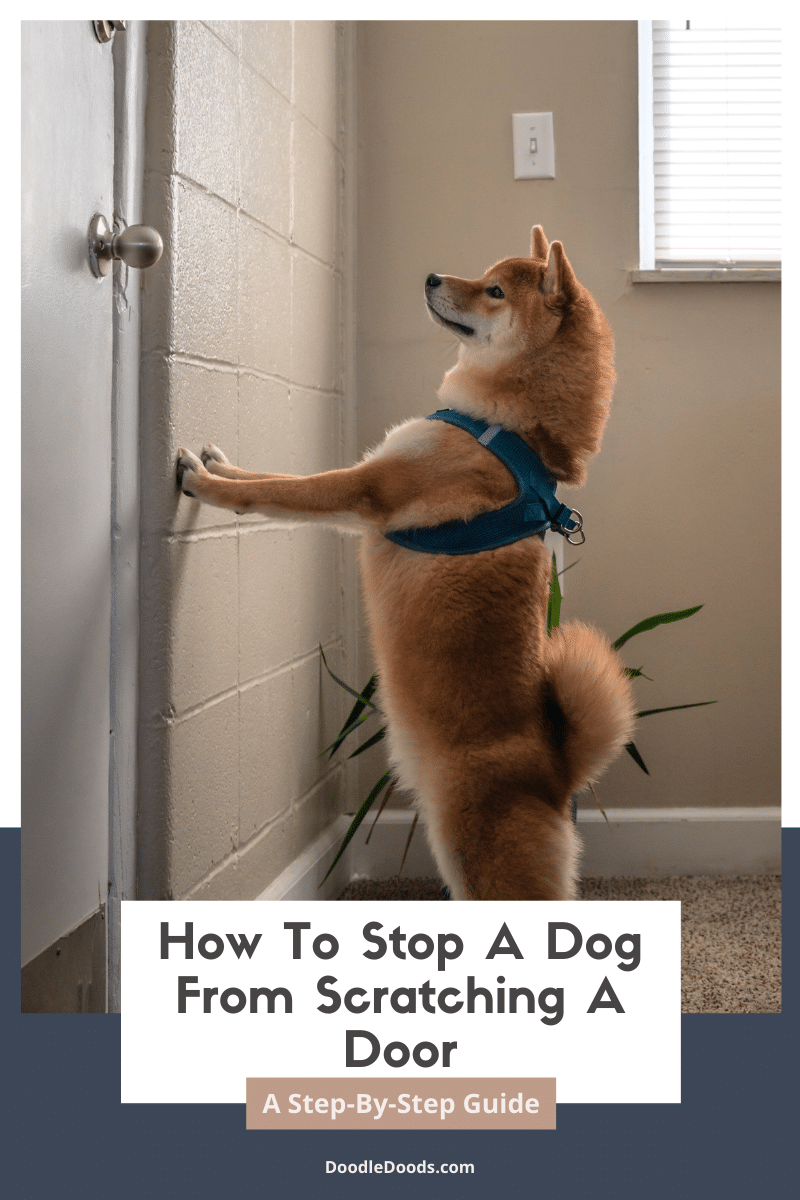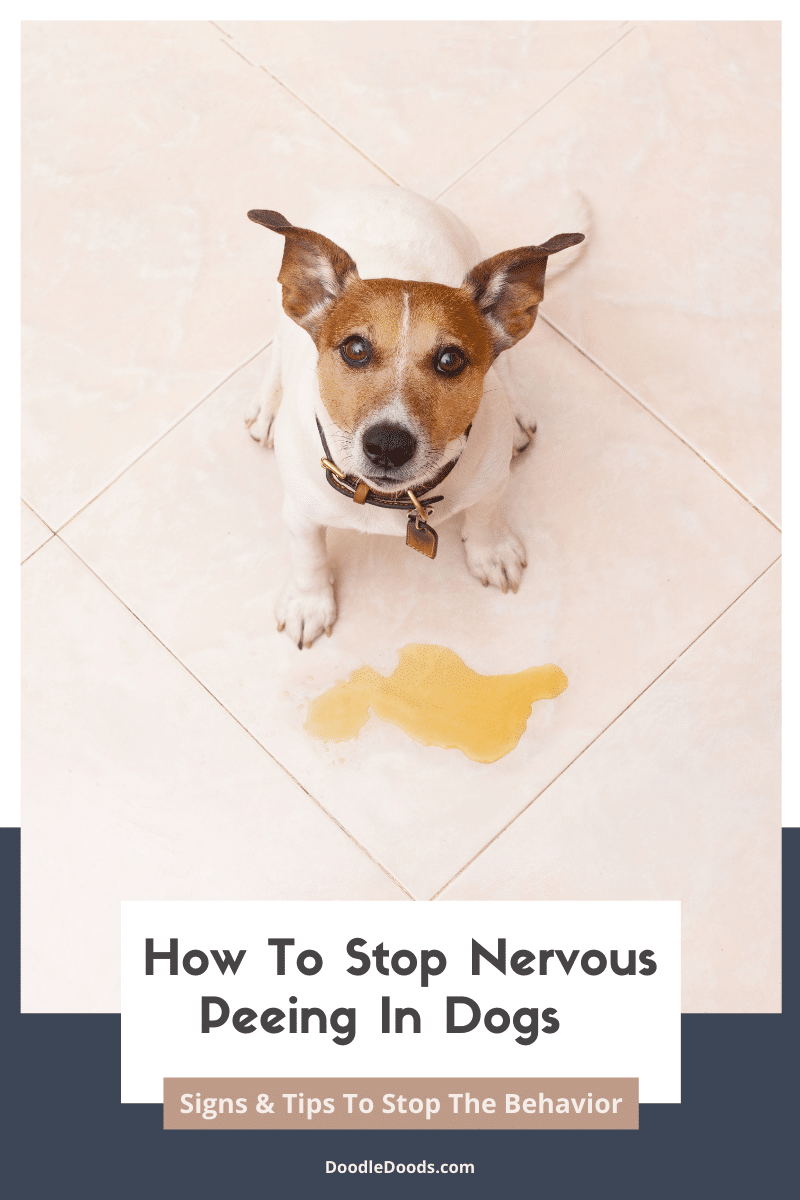How to stop a dog from scratching the door is an issue most pet owners deal with at some point or another. Usually, it’s not wanton destruction they have in mind, though. Your pup is simply trying to communicate with you in one of the ways they have learned works. However, if you’re trying to avoid nasty scratch marks and worse on every door in the house, it might be a habit you are looking to break your pet of – but how?
As with all unwanted canine behaviors, the first step in nipping it in the bud is figuring out why it’s happening in the first place. In some cases, it can be pretty obvious what your pal is after. Other times it might be more of a mystery. That’s why we’ll first outline some of the more common dog door-scratching motivations before covering some simple strategies to get them to stop. Apply the right combination of these, and you’ll be done with this pesky issue in no time at all.
Table of Contents
- Reasons Your Dog Scratches At The Door
- How To Stop Your Dog Scratching At Doors
- Frequently Asked Questions About Door Scratching Behaviors
- Final Thoughts
Reasons Your Dog Scratches At The Door
If you think about how door scratching might have evolved as a behavior, it actually makes a ton of sense. The obstacles that your pup’s ancestors would have encountered in the wild – brambles, tree branches, small rocks… – would likely have easily been shifted with some leg work. Your dog is simply carrying this over into modern-day times.
However, doors are unlikely to be so easily moved unless that is, the owner gets up and opens them. And, let’s face it, more often than not, this tends to be the case. Whether you’re responding to a signal from your pet (that they want to go outside, for instance) or simply trying to stop their relentless scratching, you are inadvertently reinforcing the behavior.
What this means is that the action has been successful in the dog’s mind, and so they will repeat it whenever they want another door opened for them. That is unless you do something to either stop them from needing to scratch at the door or being able to get at it. However, before you can do this, you’ll need to understand a little more about the ‘why’:
They Want To Go To The Bathroom
The number one reason dogs scratch at doors – especially external ones – is that they need to be let out to do their business. This is the kind of door scratching that most owners actually welcome because it’s obviously preferable to the alternative. In that way, it’s a mutually beneficial action. However, you can’t then be surprised with the behavior spills over to other, less scratch-resistant doors in the house.
They Want To Get To The Other Side
Likewise, in terms of eminently practical motivations, your four-legged friend might be scratching at doors because they simply want to get to the other side (remember the obstacle-removing technique!) Your dog knows there is something good there – be it food, their bed, or a favored family member. This is the only method they know that seems to work to remove the barrier, and so they are going to use it.
They Are Excited To Get Through The Door
Alongside this simple problem-solution thought process, a dog’s emotions can strongly influence their behavior. When your pup is incredibly excited about something – say, your arrival back to their house or heading out on a walk – this is likely to result in undesirable behaviors prompted by their excitement. Door scratching makes perfect sense in both of these situations. Your dog wants to get to you quickly or outside faster.
They Are Suffering From Separation Anxiety
Another common emotion leading to unwanted behaviors is anxiety. A predominant reason dogs get anxious is that they are left at home for larger chunks of the day. What many pet parents tend to forget is that dogs are pack animals. Doodles, especially with more family-oriented breeds in the mix, tend to be highly social pups. For this reason, they want to spend every moment they can with their favorite people.
Unfortunately, this means they tend to suffer more from separation anxiety than other breeds. This will manifest in barking, chewing, and, yes, door scratching too. Your pet is distressed and trying to get to you where they can feel safe and happy again. The Doodle’s high intelligence only adds to this because, being alone in the house, they are likely extremely bored, too. There’s only so much snoozing even a dog can do, after all!
Why You Shouldn’t Let Them Get Away With It
While door scratching may seem pretty harmless at first, especially if you have sturdy doors and your dog doesn’t look to be doing much damage to them, it can become a problem down the line for a variety of reasons. For instance, you may take your pet on a visit to a friend or relative with more delicate doors – imagine how that situation might play out… Not good!
Alternatively, if your pup is unable to get your attention, they may up the ante. More frantic scratching could have severe consequences for the door and your pet. They could crack their nails, get splinters in their paws, and even damage their gums or teeth if they get their mouth involved, which, for them, would be the next logical step.
How To Stop Your Dog Scratching At Doors
All that being said, you’ll want to get cracking on the ‘how’ part of preventing the behavior. Well, now that you know the ‘why,’ you’ll be able to map out the best plan of attack. The first thing you’ll want to do is make the action either impossible or necessary that way it won’t become further reinforced. You can do this in one of the following ways:
Invest In A Doggie Door
If the problem is toilet-related, finding a good doggie door (think cat flap, but larger) means they can take themselves off out into the backyard for potty time any time they want. Electronic doors are great as they keep your house weatherproof and also stop unwanted neighborhood pets (or worse!) from finding their way into your home. Best of all, your pup not needing you to open the door for them means they won’t have to scratch on it. So hopefully, the behavior will disappear on its own.
Take Them For Frequent Walks/Potty Breaks
In the same vein (if you’re unwilling or unable to go for the doggy door option), frequent trips outside will make it less necessary for your pet to need to scratch at the door to be let out. If you’re feeding your dog at a particular time each day, you should be able to get into a good routine of knowing when your pup will need to go. Alongside that, lovely long walks two or three times a day will provide them ample opportunities to do what is required. A further benefit is that they won’t be bugging you to let them out at home.
Block Their Access To The Door
Now, that solves the exterior door scratching issue for the time being (hopefully). However, if door scratching has leached over onto other doors in your house, you’ll need another solution. Placing something in front of the door so that your pet can’t get to it is the obvious choice. If this isn’t possible due to the door being in frequent use, a baby gate could be an alternative. This could be used in place of closing the door if the point is to restrict your pet to a certain area or put it in front of the door if your setup allows this. That way, not only is your door safe, but your dog can see what’s going on and still feel a little involved. This will make them less likely to kick up a stink.
Install a Door Protector
While each of these may work up to a point, you’re still likely to have the occasional instance where your dog can get to the door and does. That’s why another useful temporary solution might be to put something up that will protect your door from eager claws. Clawguard’s Heavy Duty Door Scratch Shield seems to be a good option. Forming a durable barrier between nails and delicate paint and wood, this protector even appears to work as a deterrent against dog door scratching, according to the reviews.
Once you’ve got these in place and working for you, you can start to focus a little on eradicating door-scratching altogether with training and counter-conditioning. Firstly, it’s good to replace the functional motivations for scratching. One method of doing this is to:
Find Another Bathroom Signal
While you want the scratching to stop, you’ll probably still want your dog to let you know when they need to head outside. An excellent alternative that innovative dog owners have come up with is training or ‘potty’ bells. A string of large silver bells, these look (and sound) like festive decorations, but they are hugely practical – and far nicer to listen to than scratch, scratch, scratch! Simply slip them over the handle of your yard door and encourage your pup to shake them when they want to be let out. Lead by example by ringing the bells whenever you let your pal out; they should quickly get the idea.
For all other times when the action is definitely not wanted, try the following:
Ignore The Behavior
As attention-grabbing often lies at the heart of door-scratching behavior, to encourage your pup away from doing it, the very best thing you can do is to remove the reward. In this way, they are not getting what they want from their action, which gives them no motivation to do it. However, it’s not going to be quite that simple.
Firstly, it will be very tough for you not to respond in any way to the scratching. Even if you’ve found a way to protect your door and so don’t have to worry on that front, the noise alone can be enough to drive you mad! However, even if you don’t open the door, if you give your hound any kind of attention at this point – even to reprimand them, you are still going to be somewhat reinforcing their behavior. That’s why ignoring it is crucial. It’s the first step in training your dog to act in a different way.
Secondly, when unlearning a behavior, dogs frequently go through a process known as an ‘extinction phase.’ During this time, they will ramp up the undesirable actions in the hopes that this will get your attention and earn them a similar response as previously. If you find this gets to be over-the-top to the point where you are struggling to ignore it, you may find you get faster results if you actually remove yourself from the situation entirely by going to another room, for instance. This links the scratching with a negative consequence in your dog’s mind, and they will want to avoid this.
Use Corrective Commands
While shouting is not the best approach to disciplining your hound for various reasons, including the fact that it won’t make any sense to your pet and could even end up impairing your relationship, firmly issued commands are a whole other story. When you catch your dog in the act of scratching, get their attention, look them in the eye, and issue a firm “no.” Your pup needs to understand your disapproval, but don’t give them anything more than that, as, again, you will be reinforcing the behavior.
Eventually, the command alone should be enough to stop them in their tracks. Once you have reached this point, encourage your hound to do something else you ask them to do, such as sit. When they can do this calmly, give them a treat as a reward. They are now listening to you and learning another, better way to get your attention.
Reduce Excitement Levels
The above step leads very nicely onto this next one. If your dog is scratching at the door because they want to get out on their walk faster, don’t let them get away with this. When they start, get their attention and try the ‘no’ command. If this works, you can then get them to sit and reward them. If they remain calm, you can take them out for their walk. But,if it doesn’t work, then walk away from them. Make it clear to your pup that you won’t be taking them for a walk while they are doing what they are doing. You might also try keeping them away from the door by tethering their leash to something until they are in a calmer frame of mind and more ready to listen to you.
Keep Your Pet In Check
For door scratching that happens because something exciting is happening on the other side, such as a visitor, you’ll want to do something similar. If the ‘no’ command works, you’re good to go. If not, do not open the door while your dog is scratching. Instead, remove them to another room or their crate before letting the person in. Your pet will soon come to associate the action with being taken away (another negative consequence) and should be able to pick up the hint.
Likewise, if your dog is scratching at the door in response to you returning to the house, try the command. If that doesn’t work, remove your attention. This may mean ignoring your pet until they calm down. Or, if someone else is in the house, you can ask them to put your pup in another room or their crate until they have calmed down. Eventually, you should be able to get them to sit and wait more patiently at the door in each situation.
It also helps that dogs tend to become less excitable after the age of two. So you may find that this behavior naturally calms down beyond this point. Plus, they will have become accustomed to you coming and going and will stop worrying that you might not return every time you leave!
Provide A Little Light Entertainment
When you can’t figure out what your pet is trying to get at, boredom may well be a factor. Especially if your pooch isn’t getting enough attention at that point in time. More energetic Doods require longer walks, so you might try taking them out a little more frequently if you can squeeze it in. However, something else these pups need plenty of is mental stimulation. More often than not, the breeds used to create bigger Doodles are the descendants of (or come directly from) working dogs. This means they need to think as well as do.
That’s where games and toys can really come into their own. While balls and tug toys can be super fun for all the family, you can also buy puzzle toys to keep your pet entertained even when you’re not about to play with them. These often involve them needing to try and figure out how to get at a treat placed on the inside of the toy.
On the other hand, if you have time to try something new (and you think your pup might be up to it), why not work on training them to obey new commands or look into canine sports and agility classes in your local area? These can all be great fun for you and your family, and you get to level up your pet’s skills and abilities, all while keeping them happy, healthy, and entertained too. It really is a win-win!
Treat Their Separation Anxiety
Boosting your pet’s physical and mental stimulation can also help with the struggle against separation anxiety. On the whole, though, it’s best to figure out a way not to leave your pet home alone for extended periods if you can. Obviously, you need to go to work, but maybe you have a friend or family member who could check in on your pooch, let them out for a pee, and spend a little time with them. If not, there are dog walking services you could look into or even day boarding kennels which could be an option.
That being said, if your pet is struggling with spending any time at all by themselves, this is an issue in itself that needs to be addressed. Creating a safe space for your pooch – somewhere they can feel happy – is a good first step. That’s why some owners swear by crate training. Pet cameras are another handy way to keep in touch with your dog during the day. However, you might also need to look into various techniques for helping your fur baby feel more comfortable alone.
Frequently Asked Questions About Door Scratching Behaviors
If your pal is scratching at the door just as you leave the house, this is about them wanting to come along with you. Dogs are very social animals – they want to be with their family always, and they often don’t relish being left behind. However, if your pet is scratching the door long after you are gone, you might be dealing with separation anxiety.
Many dogs learn to scratch at the door because when they do this, it gets a favorable response for their owner. Either the door will be opened for them, or they will get some kind of attention. Every time their motivation is fulfilled, the behavior because more firmly reinforced, making it more likely that they will repeat it over and over again.
If your mutt goes crazy either when you’re taking them out or when someone is coming through the door, the only way you’re going to be able to address this problem is through training. Ensure your dog doesn’t get what they want (so you’re not reinforcing the behavior further). Instead, encourage them to wait calmly for the door to be opened.
Separation anxiety is a whole other issue that needs to be looked at aside from door scratching because it’s about how your dog feels when they are left home alone. As the action is emotion-based, it’s tough to tackle it (especially when you’re not even there), so in this case, you might need to change their environment so they can’t get to the door.
If your dog is scratching at doors at night, it could be that they are hearing something happening around the house. Alternatively, if they are a particularly velcro-like hound, they might be signaling to you that they are not happy with sleeping alone. If you’re not happy to relocate their bed to your room, perhaps set them up in a snugger space (a laundry room, a larger room under the stairs… ) where they can feel safe and comfortable.
Final Thoughts
If your dog won’t quit with their scratching at your doors, this can be frustrating not just because of the noise factor but because of the potential for damage. Happily, there are various techniques you can employ to keep your doors safe from harm by making them inaccessible, making the action unnecessary, and by training your dog to behave in another way. Hopefully, the information here proves useful in helping you to both identify why your dog is doing what they are doing and in fixing it too.
Learn How to Stop Shavedowns For Good & Keep Matting At Bay!

Discover the PROPER Doodle coat care routine that gets your pup to cooperate…helps you nip tangles in the bud…and gets groomers to do exactly what you want.
Plus, get $520 worth of Bonus Materials for FREE, including:- Doodle Parenthood Community and Support Group ($190 value)
- Custom Doodle Coat Care Plan Lifetime Access ($75 value)
- Easy to Use Doodle Grooming Tracker ($20 value)
- And MORE!












